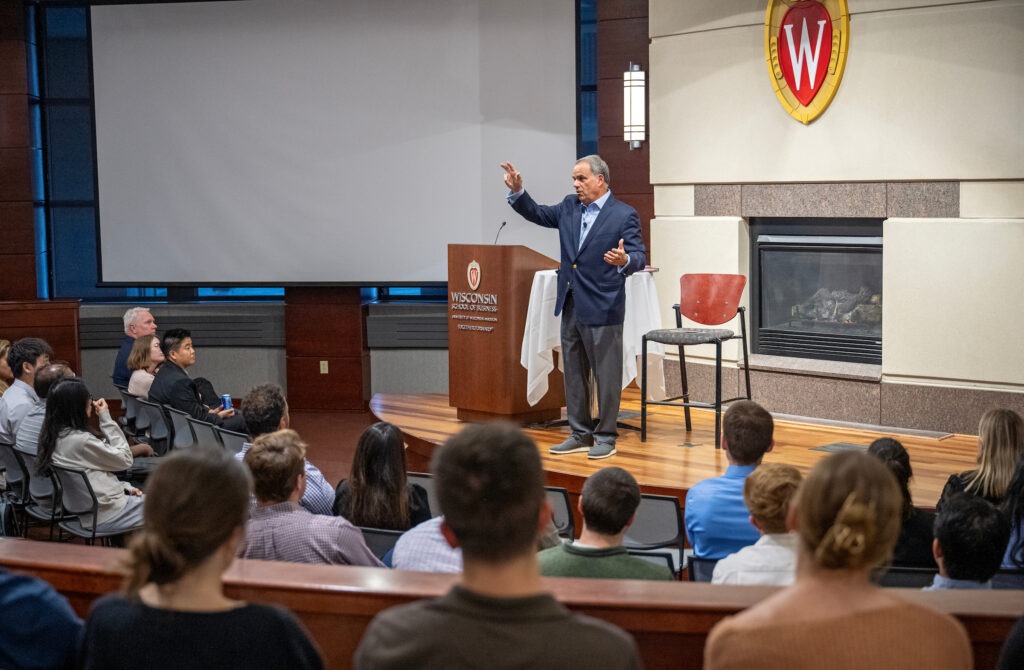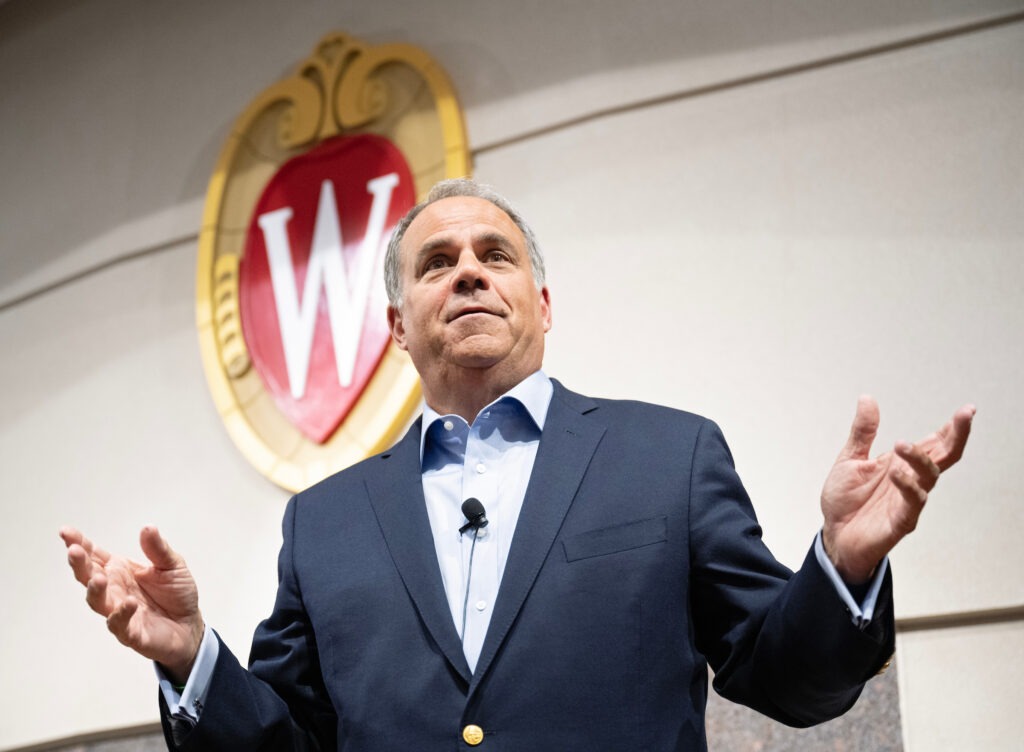Leadership is not a spectator sport.
That’s according to Bob Trunzo—and as CEO and president of TruStage (formerly CUNA Mutual Group), he knows a thing or two about leadership.
Trunzo joined the company in 2005 and became CEO in 2014. He calls himself the “least likely CEO”; if you had seen him 20 years ago, Trunzo says, you would have thought, “That guy will never be a CEO.” Yet over the course of his career, he learned to embrace active leadership, mastered the art of unlocking employee potential, and guided TruStage to greater success—helping customers build a better financial future along the way.
Though his career is coming to a close with his planned retirement, he is eager to share his hard-earned wisdom with the next generation of business leaders. For an audience of Wisconsin MBA students, faculty, staff, and alumni, Trunzo gave his perspective on the importance of “leading by example” as part of the M. Keith Weikel MBA Leadership Speaker Series.

1. Put the customer front and center.
To Trunzo, keeping a business on a successful trajectory isn’t all that complicated. Business success is ultimately rooted in customer satisfaction and retention—so it only makes sense to put customers at the center of every decision.
“At the end of the day, if you really listen and you ask the right questions, your customers are going to tell you everything you need to know about your products and about your business,” Trunzo said.
This was a major focus for Trunzo when he stepped into the role of TruStage CEO. Under his leadership, the company implemented a customer-centric strategy, which Trunzo made sure could be summed up in just “a couple bullet points.” The reason for the simplicity? So all employees could understand what they were working toward and why.
“You need everybody in a 4,000-person organization to pull in the same direction,” Trunzo explained. “Because if they don’t, it is a mess.”
“At the end of the day, if you really listen and you ask the right questions, your customers are going to tell you everything you need to know about your products and about your business.”
—Bob Trunzo
In some cases, better serving TruStage customers didn’t mean adding products or doing more. At times, it meant doing less. And while shutting down ineffective processes was a necessary task for Trunzo, it wasn’t an easy one.
“The most difficult thing in an organization when you’re the CEO—and you all will see this as you rise up the corporate ladders—is making decisions to shut things down,” he said. “It takes more guts for a CEO to say, ‘We’re not going to do that, because we stink at it’ or ‘we can’t make money at it’ or ‘we don’t serve our customer the right way’ than throwing money at innovation in projects.”
2. Embrace change.
According to Trunzo, any company that is stagnant is in trouble. Just as the world is constantly evolving, businesses also must adapt to stay relevant—and it’s up to a company’s leaders to anticipate the best next steps.
To expand upon this philosophy, Trunzo cited a piece of advice he received from a professor in his executive MBA program: “Good CEOs operate the company day to day. Outstanding CEOs look over the horizon and plot a chart on where they want the company to go.”
But the change required by future-focused leadership can be difficult—not only for the leaders but for everyone within an organization.
“Change is messy,” Trunzo admitted. “It makes people uncomfortable; it makes people cranky; it makes people think, ‘Are we ever going to come out of this?’ And if you do it effectively, and if you do it focused, you’ll come out of it, and you’ll come out of it better—more in tune and more aligned with your customer.”

3. Prioritize culture.
Trunzo has highly prioritized company culture during his tenure at TruStage. The reason is simple: People spend a lot of time at work, so he wants to make it the best possible experience for them.
Under his guidance, the company created employee resource groups to connect people and help them feel valued within the company. The groups range from supporting single mothers to supporting members of the LGBTQ+ community.
But ensuring employees feel valued and comfortable at work requires more than helping them find community; they need to know their leaders support them, Trunzo said. To illustrate this, he recalled that throughout 2020, when America was reckoning with a series of racial injustices, Trunzo made sure to discuss the events with his employees. The decision by many CEOs to ignore the tension baffled him.
“How can you have a culture where you want people to feel that they can be their own self in the workplace and not talk about some of these issues?” he reflected.
When it comes down to it, Trunzo’s motivation behind his actions stems from the desire to create an environment where people want to come to work. Doing so not only provides a better day-to-day experience for employees, but it also fuels employees’ passion for their role and the company. That passion is then reflected in their work, ultimately creating a better experience for customers.
4. Be an active, direct leader.
Leaders should be bold, never shying away from taking charge. According to Trunzo, when leaders don’t step up and make decisions, people who are less qualified inevitably make them instead. This can create confusion and misalignment within an organization.
“Come with a position; defend your position,” he said, and added, “Come with the facts and make decisions.”
Of course, even when leaders bring the facts, they can make mistakes—but Trunzo said once he chooses a course of action, he doesn’t often look back. For one, he simply doesn’t have that luxury in his role. But for another, he understands that progress isn’t always linear. Sometimes an organization may take few steps forward, then sideways, before moving forward again.
“It’s a journey,” Trunzo said.
“Come with the facts and make decisions.”
—Bob Trunzo
5. Consider your own needs.
Trunzo encourages people to seek out a mentor. Mentors have played an important role in his career, even as CEO. While talking with colleagues or a significant other may be convenient, Trunzo advises finding someone specifically for this purpose—someone you respect, a role model.
“It is incredibly therapeutic to talk to someone that’s not in the day-to-day morass that we’re all in,” he explained. He added, “You will be shocked sometimes at how narrow your vision is. … You’ll be shocked at what you’re missing.”
Trunzo also stresses the value of making quality time for yourself in order to reset, which he admits is something he didn’t do enough of throughout his career.
“Work-life balance … I had none. Don’t follow me,” he urged.
This “me time,” as Trunzo calls it, is not only important for mental health, but it can provide sharpened focus, helping leaders be more effective in their roles and make better decisions.
“It’s really important to think about how to fit that into your schedule,” Trunzo said. “Carve it out.”
Bob Trunzo retired from his role as TruStage CEO and president at the end of September 2023.
